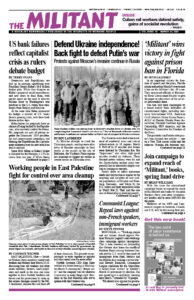Below are excerpts from “Revolution, Counterrevolution and War in Iran, Social and Political Roots of Workers’ Protests That Swept 90 Cities and Small Towns,” from the Militant in April 2018.
The historic Iranian Revolution of 1979 was a deep-going, modern, popular social revolution in city and countryside, not a religious jihad as it is falsely portrayed by bourgeois voices. …
Members of the communist party in Iran at that time — the Socialist Workers Party (HKS), later renamed the Workers Unity Party (HVK) — were in the thick of the revolutionary class struggle. They were workers in factories, refineries and other industrial workplaces, as well as volunteer soldiers combating the Iraqi invasion. Many of that party’s cadres and leaders had been recruited and trained by the Socialist Workers Party in the United States while studying or working here during the tyrannical reign of the shah. Other workers, soldiers and students were won to the party in Iran during the opening years of the revolution.
The HVK advocated “extension and unification of factory shoras”; “land distribution under the control of peasant shoras”; “the right of self-determination [and] autonomy” of Kurds and other oppressed nationalities; and equal rights for women, including “the right to work and equal pay for equal work,” “child care,” and “against compulsory veiling and any kind of discrimination and humiliation of women.” The HVK demanded full political liberties and the release of “all anti-imperialist and working-class political prisoners,” and called for “the extension and unification of workers, peasants, soldiers and Pasdaran [Revolution Guard] shoras. For a workers and peasants government.”
In the United States and around the world, it was only in the pages of the Militant … that working people could find accurate, firsthand accounts of the Iranian Revolution and efforts by working people and the oppressed to defend and advance it in face of assaults by U.S. imperialism, by hostile regimes in the region, and by bourgeois forces in Iran itself. Members of Socialist Workers Party branches and trade union fractions in the United States took the truth about the revolution and our defense of it to co-workers in factories, mines and other workplaces, as well as into the streets.
By the early 1980s, however, the bourgeoisie and Islamic Republic were employing increasingly brutal repression to turn back and defeat struggles by working people and the oppressed, consolidating the rulers’ counterrevolutionary clutch at home.
After Iranian military forces pushed Saddam Hussein’s invading army back across the border in mid-1982, Tehran sent its own troops into Iraq in large numbers. Whatever defensive purpose this initially served, the Tehran regime over the next several years sent wave after wave of teenage and other young Iranian working people to needless slaughter as it assaulted population centers in Iraq. …
By the end of 1982, a combination of official and government-sponsored thug terror made it impossible for communists to any longer carry out political activity in Iran. The record of the proletarian internationalist course and unbroken continuity of that communist party, however, exists to be studied by new generations and put into practice as conditions permit. A good starting point can be found in issue no. 7 of New International.

